This article was medically reviewed by Sarah Gehrke, RN, MS. Sarah Gehrke is a Registered Nurse and Licensed Massage Therapist in Texas. Sarah has over 10 years of experience teaching and practicing phlebotomy and intravenous (IV) therapy using physical, psychological, and emotional support. She received her Massage Therapist License from the Amarillo Massage Therapy Institute in 2008 and a M.S. in Nursing from the University of Phoenix in 2013.
This article has been viewed 349,440 times.
You may think all you've got to do to read a syringe is look at the lines on the tube. But different syringes measure volume in different increments, and sometimes they don’t use the standard unit, milliliters (mL). This can make the process more difficult than it looks! Always start by double-checking your syringe’s unit of measurement, and the value of each line on the tube. To get an accurate measurement, all you need to do is fill the syringe and push the plunger down to the amount you need to measure out.
Steps
Measuring by a Syringe’s Marks
-
1Check the units of your syringe. There are many different sizes of syringes. Most will be clearly marked in milliliters (mL). You'll see hash marks on the tube of the syringe. Each 1 marks a certain number of milliliters or fractions of milliliters.[1]
- Some syringes, such as those used to measure insulin, are marked in numbers of "units" rather than milliliters.
- Some older or non-standard syringes may also use different units.
-
2Count the lines on a syringe marked in even-numbered increments. Most syringes include incremental hash marks between larger, numbered ones. For instance, you might have a syringe that is marked large lines at 2 milliliters (0.068 fl oz), 4 mL, and 6 mL. Halfway between each of these large lines, you might see a slightly smaller line. In between each numbered line and the slightly smaller line, you would then see 4 even smaller lines.
- Each of the smallest lines would count for 0.2 milliliters (0.007 fl oz). For instance, the first line above the 2 milliliters (0.068 fl oz) line would equal 2.2 milliliters (0.068 fl oz), the second line above it would equal 2.4 mL.
- The mid-sized line halfway between each number would equal the odd number in between. For example, the halfway mark between 2 milliliters (0.068 fl oz) and 4 mL equals 3 mL, and the mark halfway between 4 milliliters (0.14 fl oz) and 6 mL equals 5 mL.
Advertisement -
3Read a syringe marked in consecutive increments. For instance, your syringe may be marked with a number at every successive mL. In between you'll see a mid-sized line that marks half mL units, like 0.5 milliliters (0.02 fl oz), 1.5 mL, 2.5 mL, and so on. The 4 smaller lines between every half mL and mL line each mark 0.1 mL.
- So, if you need to measure 2.3 milliliters (0.08 fl oz), draw the liquid to the third line above the 2 line. If you need to measure 2.7 milliliters (0.09 fl oz), that will be the second line above the 2.5 mL mark.
- Your syringe may be marked in other increments, such as multiples of 5 milliliters (0.17 fl oz) or in fractions of 1 milliliter (0.034 fl oz). If so, the principle stays the same—just look for the major numbers marked on the syringe, and count the smaller marks in between.
-
4Measure in between the hash marks, if necessary. Sometimes you will be asked to measure an amount that is not exactly marked by the hash lines on your syringe. To do this, you'll have to count between the lines.
- For instance, say you have been asked to measure 3.3 milliliters (0.1 fl oz) of a medication, but your syringe Is marked in hash marks of 0.2 milliliters (0.007 fl oz) increments.
- Pull the medication up the syringe and then push the plunger down until the medication is between the 3.2 milliliters (0.1 fl oz) and 3.4 mL lines.
Using a Syringe Accurately
-
1Hold the syringe by its flange. Grasp the syringe by the winged parts located on the end of the syringe opposite from the tip. This is known as the flange. Holding the syringe this way makes it so your fingers won't be in the way while you try to read the syringe.[2]
- Holding the syringe this way is also important for super-precise, scientific measurements, to ensure that your body heat from your fingers doesn't distort the material you're measuring in the syringe. For everyday measurements (like home medications), you don't need to worry about body heat distortion.
-
2Over-fill the syringe. Always use a syringe that is larger than the amount you need to measure. Insert the needle into the liquid you want to measure, then slowly pull back on the plunger until the syringe is filled past the mark for the amount you need to measure.[3]
- For instance, if you are measuring out 3 milliliters (0.10 fl oz) of a children's medication, use a 5 milliliters (0.17 fl oz) or larger syringe. Pull the plunger back until the liquid fills the syringe past the 3 mL mark.
-
3Release the plunger until it is at the mark you need to measure by. Still holding the syringe in your hand, slowly push down on the end of the plunger with your thumb until its edge is even with the point you need to measure by.[4]
- For instance, if you are measuring 3 milliliters (0.10 fl oz) of a medication, push the plunger down until it is even with the 3 mL mark.
-
4Read from the top ring of the plunger. No matter what syringe you use, always look at the part of the plunger closest to the tip when reading it. This will be the part touching the liquid that you are measuring. The part of the plunger closest to the top of the syringe is irrelevant and not meant to be used for measuring.
Warnings
- Never attempt to measure using a syringe marked in units different than the ones you're told to use. For instance, don't try to guess and measure in mL using a syringe that is marked only in teaspoons. This can lead to inaccurate readings.⧼thumbs_response⧽
- Some syringes may be marked in more than 1 unit, such as teaspoons as well as mL. Make sure to be consistent and use only 1 set of unit lines.⧼thumbs_response⧽
References
- ↑ https://pharmlabs.unc.edu/labs/parenterals/syringes.htm
- ↑ https://websites.pmc.ucsc.edu/~silab/pdf/Hamilton_Syringe%20Care%20and%20Use%20Guide.pdf
- ↑ https://websites.pmc.ucsc.edu/~silab/pdf/Hamilton_Syringe%20Care%20and%20Use%20Guide.pdf
- ↑ https://websites.pmc.ucsc.edu/~silab/pdf/Hamilton_Syringe%20Care%20and%20Use%20Guide.pdf
About This Article
To read a syringe, always start by double-checking the unit of measurement and the value of each line on the tube. Most syringes will be clearly marked in milliliters, though some older ones are in different units. Look at the larger, numbered hash marks, then count how many smaller hash marks are in between to verify if these smaller marks are half or whole units. To learn how to use a syringe accurately, keep reading!
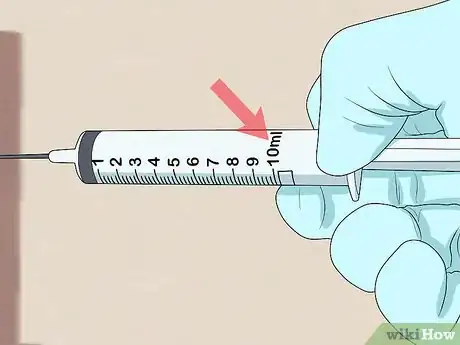
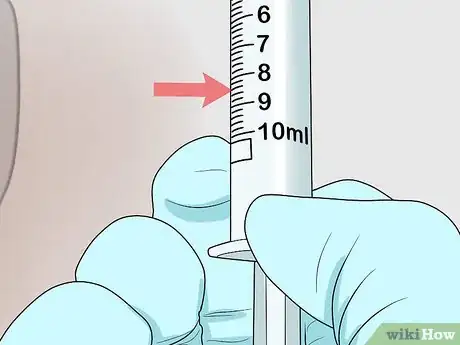
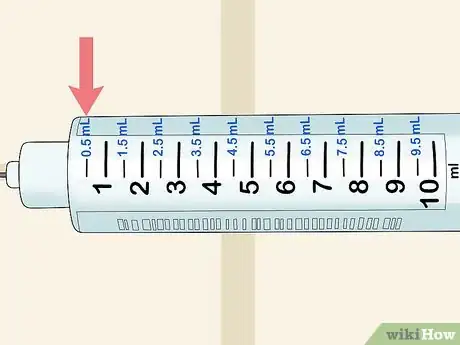
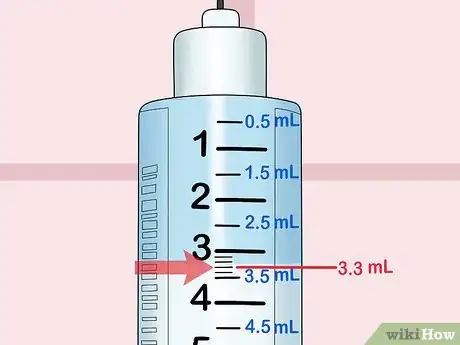
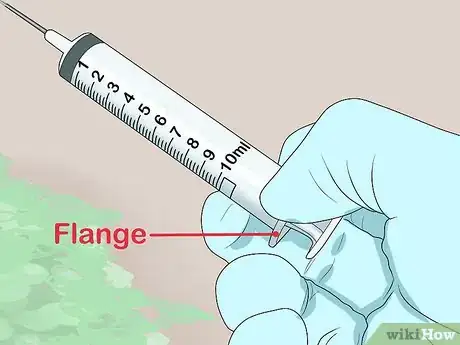
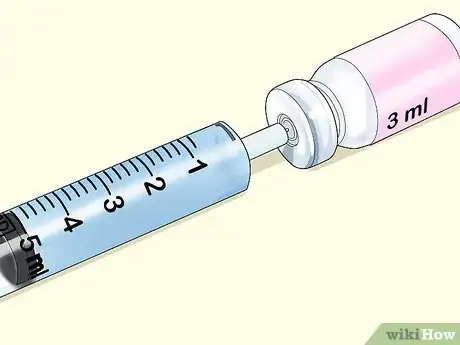
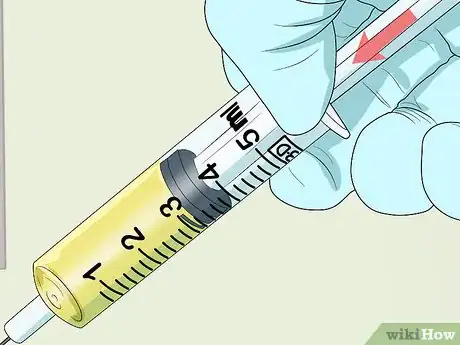
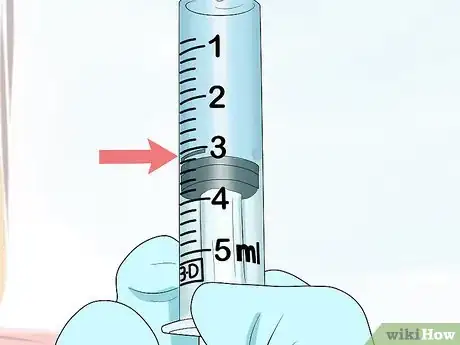
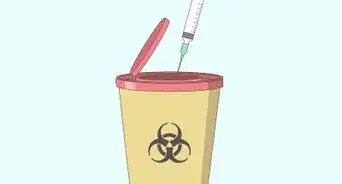







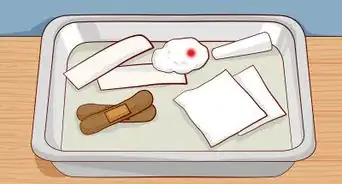
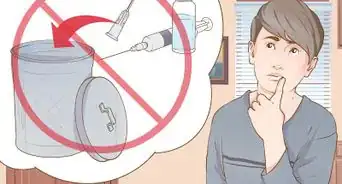



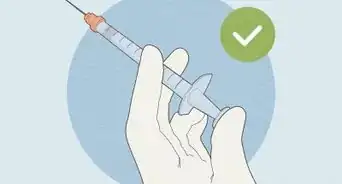


















































Medical Disclaimer
The content of this article is not intended to be a substitute for professional medical advice, examination, diagnosis, or treatment. You should always contact your doctor or other qualified healthcare professional before starting, changing, or stopping any kind of health treatment.
Read More...